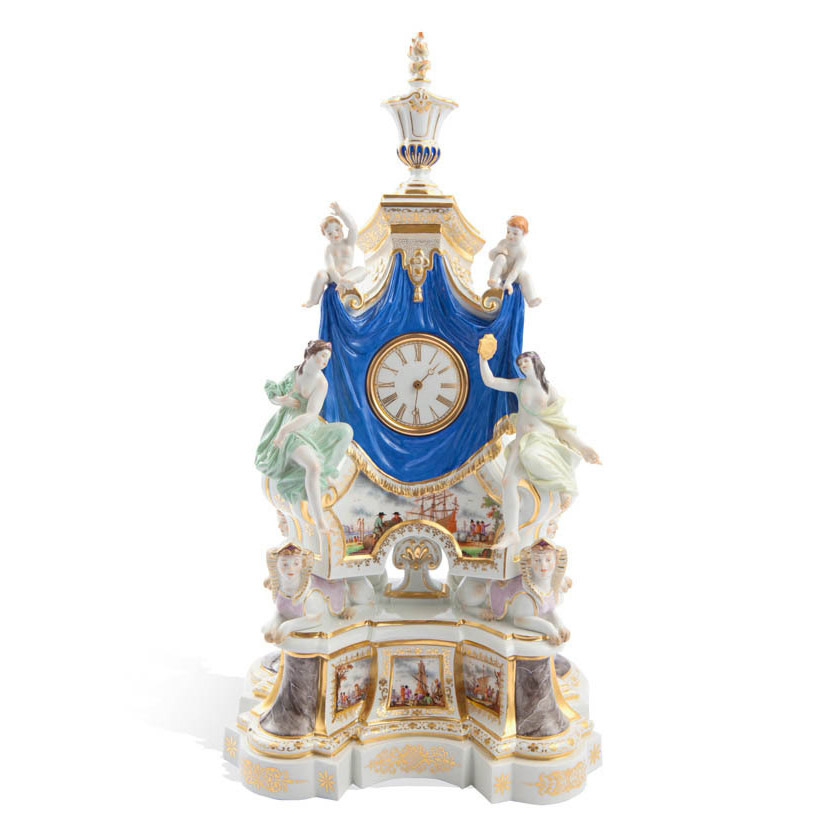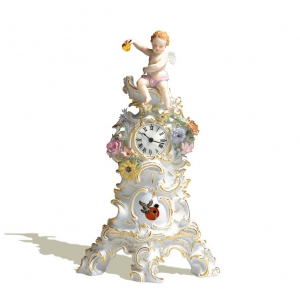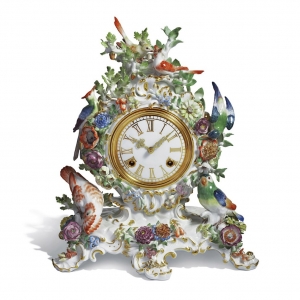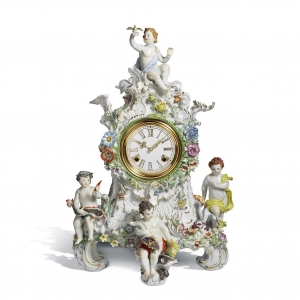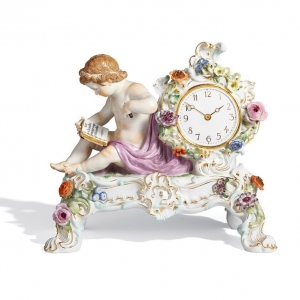Meissen mantle clocks of the 18th century
To date, there is an incredible amount of accurate time meters. It is impossible nowadays to imagine an active life with a lot of meetings, with a frantic pace of life and an eternal rush but without a clock. But time is not only a matter of counting seconds, minutes and hours. In order to understand the mystery of time, one needs to some free time.
The porcelain clocks from the Meissen manufactory provide you with unique moments to enjoy the sense of time, which flows seamlessly into minutes of unforgettable delight, admiration, fun. Meissen porcelain clock manufactory provide you with unique moments to enjoy the sense of time, which flows seamlessly into an unforgettable minutes of delight, admiration, fun. These watches are designed not only to simply decorate the house, but also help to grasp the nature of time in allegorical images, significantly expanding its concept.
Meissen clocks from the Kaendler-era (mid 18th century) are made in the typical rococo style, the main element of which was the so-called rocaille, an ornament in the shape of a shell. This ornament was actively used in the works of Kaendler from 1750 to 1760. As a symbol of organic natural origin, this pattern contrasts with the artificial automated pulse of a clock.
CLOCK “FLOWERS AND BIRDS”
This composition was created at the Meissen manufactory in the mid 18th century. At this time, the head of the model workshop was the unsurpassed Johann Joachim Kaendler, for whom one of the main themes in his work was to create realistic figures of animals and birds. At the same time, he was madly in love with overhead plastic ornaments, which was often used at the time of the rococo style.

These watches are designed to express nature’s awakening of spring in its wealth and multicolored splendor.
CLOCK “FOUR ELEMENTS”
This clock was created at the Meissen porcelain manufactory in the middle of the 18th century. It represents a composition with four putti, symbolizing the four elements that define the era of human history on our planet: water, air, earth and fire. Each putto is surrounded by different attributes and symbols that emphasize their correlation with the elements.

You can see a badger at the feet of the cherub embodying the element Earth. In one hand he holds wheat and in the other a cornucopia of fruits and grapes. He has a terracotta color bandage on his hips.
On the knees of the putto on the left, personifying the Water element, is a big fish, which he holds with his right hand. He sits near to reed and sea shells. In his left hand, he holds a sprig of red coral and on his head he wears a crown made out of reed.
The putty personifying the element Fire has hair in bright fiery colors and at its feet sits a fire-breathing dragon, out of whose mouth come flames. The putty has a very determined slightly aggressive posture and holds a sheaf of fire in its right hand.
These three allegories of Water, Earth and Fire are located on the lower level of the clock, and more concretely on the three legs of the typical Rococo classic design.
The putto depicting the Air element sits on top of the decorative setting of the clock. His robe is pale blue, as if he sits in the clouds, and in his right hand he holds a bird with outstretched wings.
Snakes biting their own tails surround the clock dial. This is a very ancient symbol, called urobόros (from the Greek ουρά - tail and βόρος - devouring). This symbol means eternity and infinity of the cyclical nature of life.
The appeal to various allegories can often be observed among 18th century sculptors of this famous manufactory. Very often, these allegories were used on the order of the Russian Empress Catherine II, who was very fond of this topic in porcelain design.
Allegories were common during the Renaissance and Classicism. An allegory is the expression of an abstract concept by a particular image. It is the artificial construct in which the characters play an important role, but which, in turn, are composed and compiled, and are taken from the real world that surrounds us, and reveal a generalized consciousness of humanity. A symbol has sustained and permanent character, but in comparison to an allegory, it can be constructed differently and be multivalued.
Symbols and allegories are essential tools of modeling images of reality. They create the idea that a particular image is not available.
CLOCK WITH FLOWERS
The era of the mid-18th century is known for her unique style at the manufactory, which is characterized by opulence and richness of ornaments. This clock is no exception.

A putto with open book with a text resembling the content and style of the love songs of troubadours sits on the rectangular basis of the clock. The meaning of the text relates to the notion and the transience of time and love, and speaks about the fact that one should not give too much attention to it, as time is never enough. Time is even ruthless with regards to our losses, which requires us to pause for a moment, but nevertheless time goes on. The cherub also holds a stylus in his left hand.
The clock dial is in Arabic numerals, which were introduced in Europe in the 11th century and practically superseded the Roman numbers by the 13th century.
The clock is further decorated with various porcelain flowers.
CLOCK “FOUR SEASONS”
The four seasons are recurrent allegories at the Meissen manufactory. This clock has a very similar basis as the on with the Four Elements. Also this clock dial is surrounded by snakes biting their own tails.

Small chubby cherubs represent the allegorical images of the four seasons. Three of them (Winter, Spring and Summer) are seated at the bottom of the clock’s basis. Winter is covered by a fur and warms his hands at the source of fire. Summer holds corn and a sickle, and wipes the sweat from his forehead with his right hand while a wreath of burnt sun leaves adorns his head. Spring holds a wreath woven from fresh flowers in his hands and wears one on the head.
Autumn is located at the top of the mantel clock. The putto symbolizes a rich harvest, holding a glass of wine. Bunches of grapes hang from his head.
Become the owner of one of these luxury mantel clocks. You will not only expand your Meissen collection, but also decorate your interior. You can purchase one in our salon in Karlovy Vary or in our web-store.

